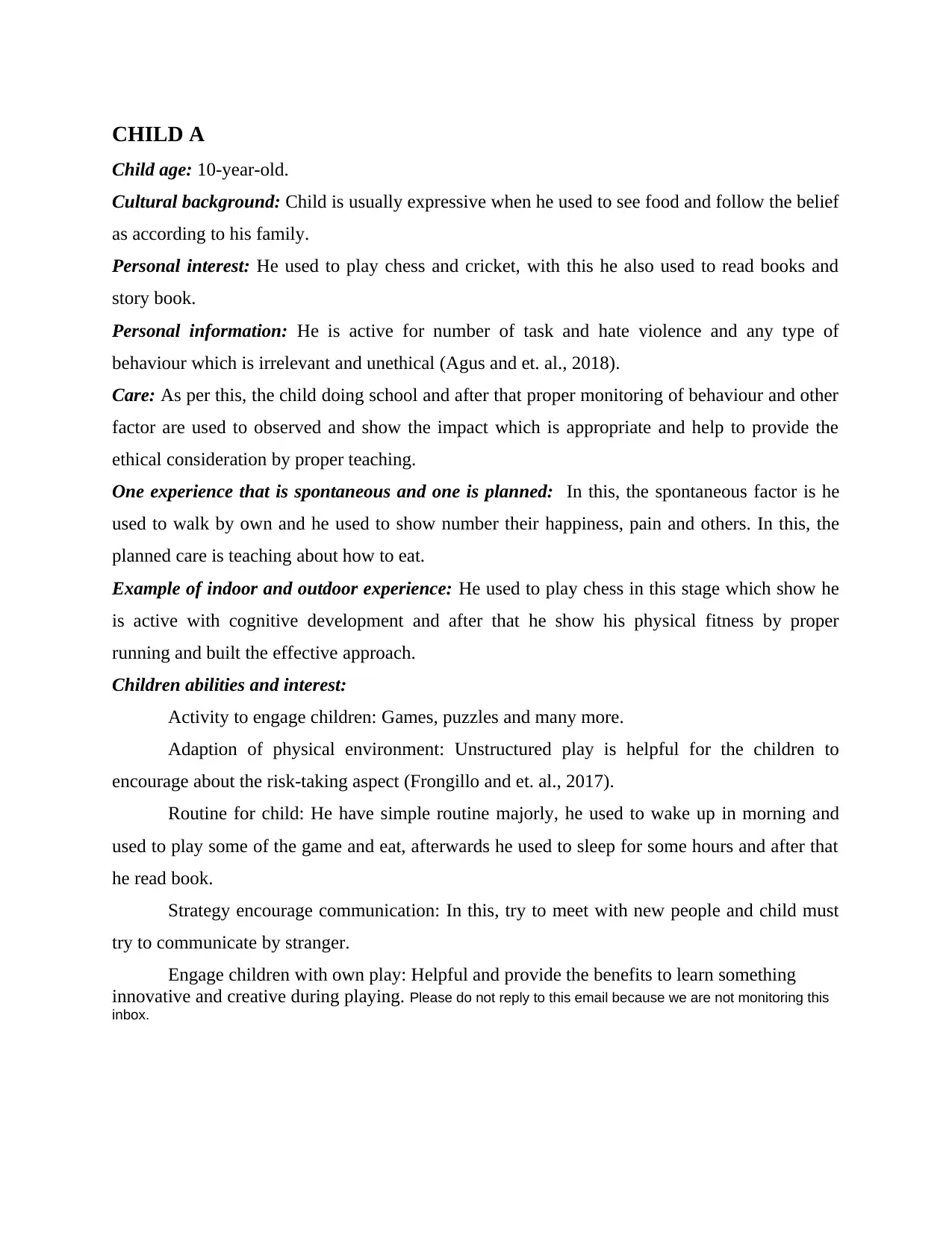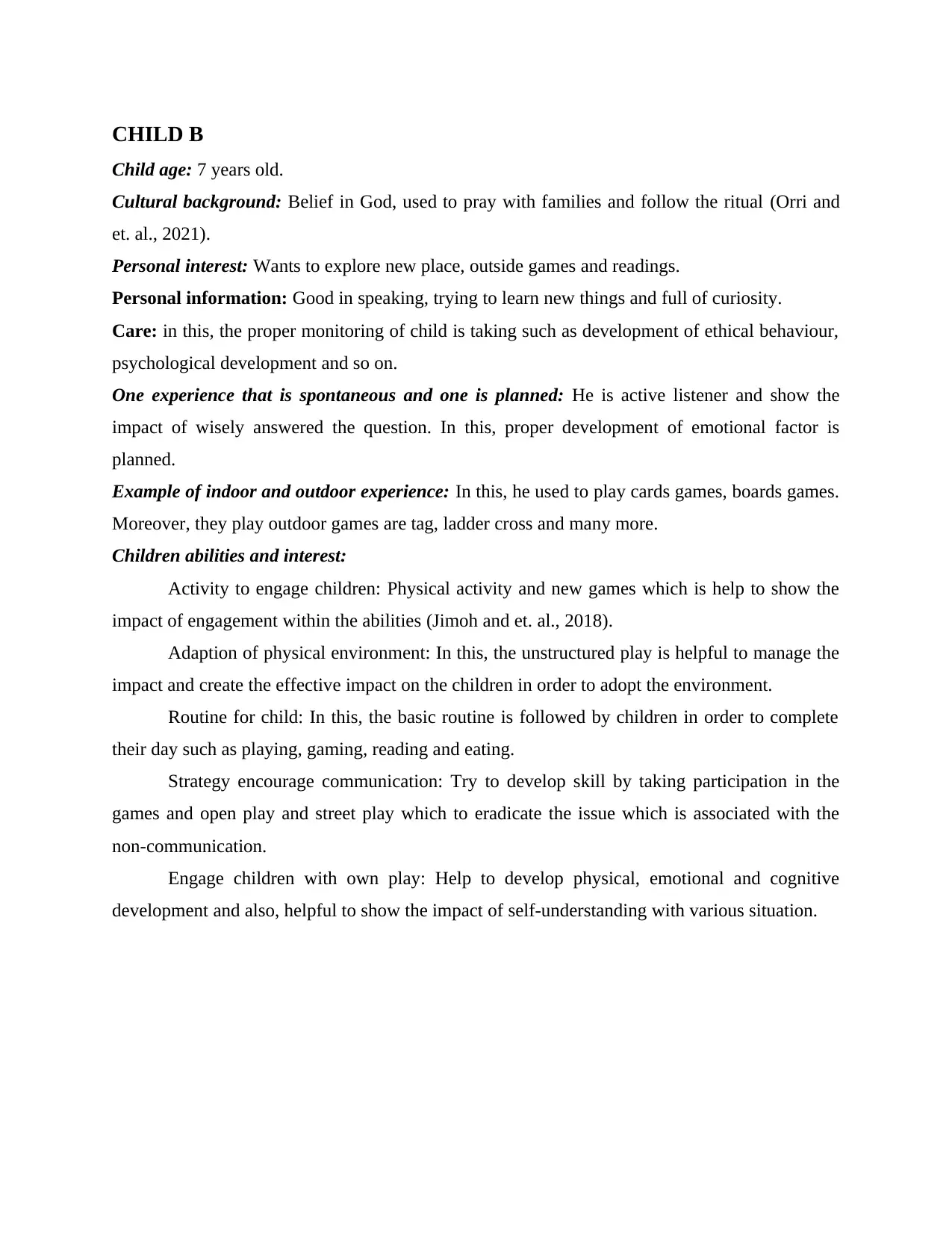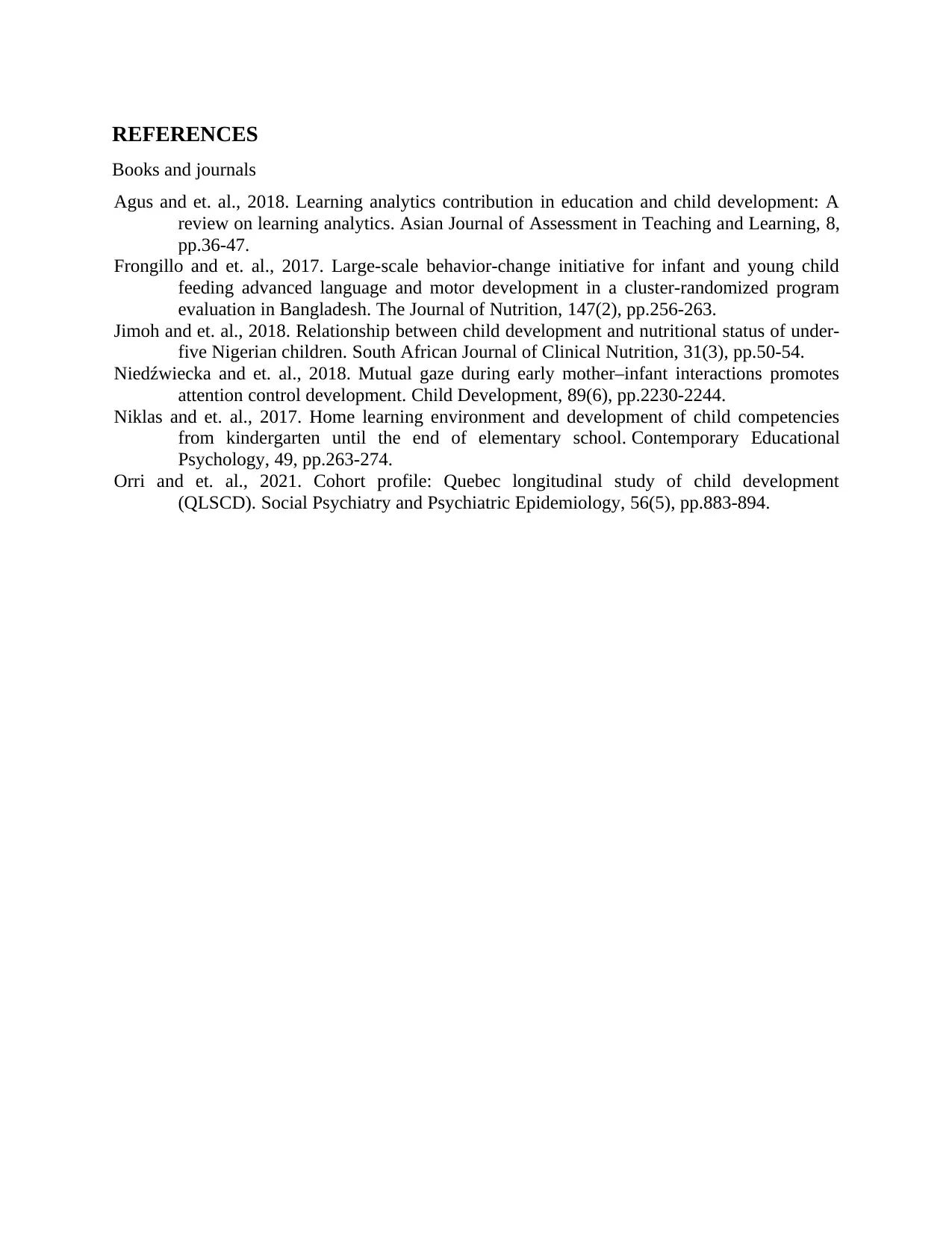Child Profiles and Care Strategies: CHCECE003 Assessment 2
VerifiedAdded on 2022/11/24
|6
|1199
|50
Homework Assignment
AI Summary
This assignment provides profiles of three children (Child A, age 10; Child B, age 7; and Child C, age 12), detailing their cultural backgrounds, personal interests, and personal information. The assignment then discusses care strategies tailored to each child's individual needs and family considerations. It outlines examples of how to promote physical activities, including both spontaneous and planned experiences, as well as indoor and outdoor activities that reflect the children's interests. The assignment also addresses educator participation in these experiences, emphasizing scaffolding for risk-taking. The document references several academic sources to support the information provided, covering various aspects of child development, including learning analytics, nutrition, social interactions, and home learning environments.

ASSESSMENT
Paraphrase This Document
Need a fresh take? Get an instant paraphrase of this document with our AI Paraphraser

Table of Contents
CHILD A.........................................................................................................................................3
CHILD B..........................................................................................................................................4
CHILD C..........................................................................................................................................5
REFERENCES................................................................................................................................6
CHILD A.........................................................................................................................................3
CHILD B..........................................................................................................................................4
CHILD C..........................................................................................................................................5
REFERENCES................................................................................................................................6

CHILD A
Child age: 10-year-old.
Cultural background: Child is usually expressive when he used to see food and follow the belief
as according to his family.
Personal interest: He used to play chess and cricket, with this he also used to read books and
story book.
Personal information: He is active for number of task and hate violence and any type of
behaviour which is irrelevant and unethical (Agus and et. al., 2018).
Care: As per this, the child doing school and after that proper monitoring of behaviour and other
factor are used to observed and show the impact which is appropriate and help to provide the
ethical consideration by proper teaching.
One experience that is spontaneous and one is planned: In this, the spontaneous factor is he
used to walk by own and he used to show number their happiness, pain and others. In this, the
planned care is teaching about how to eat.
Example of indoor and outdoor experience: He used to play chess in this stage which show he
is active with cognitive development and after that he show his physical fitness by proper
running and built the effective approach.
Children abilities and interest:
Activity to engage children: Games, puzzles and many more.
Adaption of physical environment: Unstructured play is helpful for the children to
encourage about the risk-taking aspect (Frongillo and et. al., 2017).
Routine for child: He have simple routine majorly, he used to wake up in morning and
used to play some of the game and eat, afterwards he used to sleep for some hours and after that
he read book.
Strategy encourage communication: In this, try to meet with new people and child must
try to communicate by stranger.
Engage children with own play: Helpful and provide the benefits to learn something
innovative and creative during playing. Please do not reply to this email because we are not monitoring this
inbox.
Child age: 10-year-old.
Cultural background: Child is usually expressive when he used to see food and follow the belief
as according to his family.
Personal interest: He used to play chess and cricket, with this he also used to read books and
story book.
Personal information: He is active for number of task and hate violence and any type of
behaviour which is irrelevant and unethical (Agus and et. al., 2018).
Care: As per this, the child doing school and after that proper monitoring of behaviour and other
factor are used to observed and show the impact which is appropriate and help to provide the
ethical consideration by proper teaching.
One experience that is spontaneous and one is planned: In this, the spontaneous factor is he
used to walk by own and he used to show number their happiness, pain and others. In this, the
planned care is teaching about how to eat.
Example of indoor and outdoor experience: He used to play chess in this stage which show he
is active with cognitive development and after that he show his physical fitness by proper
running and built the effective approach.
Children abilities and interest:
Activity to engage children: Games, puzzles and many more.
Adaption of physical environment: Unstructured play is helpful for the children to
encourage about the risk-taking aspect (Frongillo and et. al., 2017).
Routine for child: He have simple routine majorly, he used to wake up in morning and
used to play some of the game and eat, afterwards he used to sleep for some hours and after that
he read book.
Strategy encourage communication: In this, try to meet with new people and child must
try to communicate by stranger.
Engage children with own play: Helpful and provide the benefits to learn something
innovative and creative during playing. Please do not reply to this email because we are not monitoring this
inbox.
⊘ This is a preview!⊘
Do you want full access?
Subscribe today to unlock all pages.

Trusted by 1+ million students worldwide

CHILD B
Child age: 7 years old.
Cultural background: Belief in God, used to pray with families and follow the ritual (Orri and
et. al., 2021).
Personal interest: Wants to explore new place, outside games and readings.
Personal information: Good in speaking, trying to learn new things and full of curiosity.
Care: in this, the proper monitoring of child is taking such as development of ethical behaviour,
psychological development and so on.
One experience that is spontaneous and one is planned: He is active listener and show the
impact of wisely answered the question. In this, proper development of emotional factor is
planned.
Example of indoor and outdoor experience: In this, he used to play cards games, boards games.
Moreover, they play outdoor games are tag, ladder cross and many more.
Children abilities and interest:
Activity to engage children: Physical activity and new games which is help to show the
impact of engagement within the abilities (Jimoh and et. al., 2018).
Adaption of physical environment: In this, the unstructured play is helpful to manage the
impact and create the effective impact on the children in order to adopt the environment.
Routine for child: In this, the basic routine is followed by children in order to complete
their day such as playing, gaming, reading and eating.
Strategy encourage communication: Try to develop skill by taking participation in the
games and open play and street play which to eradicate the issue which is associated with the
non-communication.
Engage children with own play: Help to develop physical, emotional and cognitive
development and also, helpful to show the impact of self-understanding with various situation.
Child age: 7 years old.
Cultural background: Belief in God, used to pray with families and follow the ritual (Orri and
et. al., 2021).
Personal interest: Wants to explore new place, outside games and readings.
Personal information: Good in speaking, trying to learn new things and full of curiosity.
Care: in this, the proper monitoring of child is taking such as development of ethical behaviour,
psychological development and so on.
One experience that is spontaneous and one is planned: He is active listener and show the
impact of wisely answered the question. In this, proper development of emotional factor is
planned.
Example of indoor and outdoor experience: In this, he used to play cards games, boards games.
Moreover, they play outdoor games are tag, ladder cross and many more.
Children abilities and interest:
Activity to engage children: Physical activity and new games which is help to show the
impact of engagement within the abilities (Jimoh and et. al., 2018).
Adaption of physical environment: In this, the unstructured play is helpful to manage the
impact and create the effective impact on the children in order to adopt the environment.
Routine for child: In this, the basic routine is followed by children in order to complete
their day such as playing, gaming, reading and eating.
Strategy encourage communication: Try to develop skill by taking participation in the
games and open play and street play which to eradicate the issue which is associated with the
non-communication.
Engage children with own play: Help to develop physical, emotional and cognitive
development and also, helpful to show the impact of self-understanding with various situation.
Paraphrase This Document
Need a fresh take? Get an instant paraphrase of this document with our AI Paraphraser

CHILD C
Child age: 12 years old.
Cultural background: She is religious and belief in god by heart, pray at their basic routine.
Personal interest: Used to interact with new people and share her thought and want to know
about the various aspect of new world.
Personal information: She is ambitious and used to follow path by evaluating and investigating
and topper of class.
Care: They used to focus on the various parts of academic, monitor the level of curiosity.
One experience that is spontaneous and one is planned: In this, she is good communication
and share their thought to everyone is experienced. As per this, the planned is to make the proper
support for the learning and developing new skill which is effective in term of career and
development (Niedźwiecka and et. al., 2018).
Example of indoor and outdoor experience: cards games and tennis ball race. The outside are
tag and ladder toss.
Children abilities and interest:
Activity to engage children: Games, puzzle game and so on.
Adaption of physical environment: unstructured play is effective to manage the the
physical imbalance.
Routine for child: Have a proper routine and time which is stated that she is punctual and
splendid for their work and task.
Strategy encourage communication: she is already interactive and show positive impact
while they communicate with number of people.
Engage children with own play: Helpful for the development of cognitive and as well as
emotional development (Niklas and et. al., 2017).
Child age: 12 years old.
Cultural background: She is religious and belief in god by heart, pray at their basic routine.
Personal interest: Used to interact with new people and share her thought and want to know
about the various aspect of new world.
Personal information: She is ambitious and used to follow path by evaluating and investigating
and topper of class.
Care: They used to focus on the various parts of academic, monitor the level of curiosity.
One experience that is spontaneous and one is planned: In this, she is good communication
and share their thought to everyone is experienced. As per this, the planned is to make the proper
support for the learning and developing new skill which is effective in term of career and
development (Niedźwiecka and et. al., 2018).
Example of indoor and outdoor experience: cards games and tennis ball race. The outside are
tag and ladder toss.
Children abilities and interest:
Activity to engage children: Games, puzzle game and so on.
Adaption of physical environment: unstructured play is effective to manage the the
physical imbalance.
Routine for child: Have a proper routine and time which is stated that she is punctual and
splendid for their work and task.
Strategy encourage communication: she is already interactive and show positive impact
while they communicate with number of people.
Engage children with own play: Helpful for the development of cognitive and as well as
emotional development (Niklas and et. al., 2017).

REFERENCES
Books and journals
Agus and et. al., 2018. Learning analytics contribution in education and child development: A
review on learning analytics. Asian Journal of Assessment in Teaching and Learning, 8,
pp.36-47.
Frongillo and et. al., 2017. Large-scale behavior-change initiative for infant and young child
feeding advanced language and motor development in a cluster-randomized program
evaluation in Bangladesh. The Journal of Nutrition, 147(2), pp.256-263.
Jimoh and et. al., 2018. Relationship between child development and nutritional status of under-
five Nigerian children. South African Journal of Clinical Nutrition, 31(3), pp.50-54.
Niedźwiecka and et. al., 2018. Mutual gaze during early mother–infant interactions promotes
attention control development. Child Development, 89(6), pp.2230-2244.
Niklas and et. al., 2017. Home learning environment and development of child competencies
from kindergarten until the end of elementary school. Contemporary Educational
Psychology, 49, pp.263-274.
Orri and et. al., 2021. Cohort profile: Quebec longitudinal study of child development
(QLSCD). Social Psychiatry and Psychiatric Epidemiology, 56(5), pp.883-894.
Books and journals
Agus and et. al., 2018. Learning analytics contribution in education and child development: A
review on learning analytics. Asian Journal of Assessment in Teaching and Learning, 8,
pp.36-47.
Frongillo and et. al., 2017. Large-scale behavior-change initiative for infant and young child
feeding advanced language and motor development in a cluster-randomized program
evaluation in Bangladesh. The Journal of Nutrition, 147(2), pp.256-263.
Jimoh and et. al., 2018. Relationship between child development and nutritional status of under-
five Nigerian children. South African Journal of Clinical Nutrition, 31(3), pp.50-54.
Niedźwiecka and et. al., 2018. Mutual gaze during early mother–infant interactions promotes
attention control development. Child Development, 89(6), pp.2230-2244.
Niklas and et. al., 2017. Home learning environment and development of child competencies
from kindergarten until the end of elementary school. Contemporary Educational
Psychology, 49, pp.263-274.
Orri and et. al., 2021. Cohort profile: Quebec longitudinal study of child development
(QLSCD). Social Psychiatry and Psychiatric Epidemiology, 56(5), pp.883-894.
⊘ This is a preview!⊘
Do you want full access?
Subscribe today to unlock all pages.

Trusted by 1+ million students worldwide
1 out of 6
Related Documents
Your All-in-One AI-Powered Toolkit for Academic Success.
+13062052269
info@desklib.com
Available 24*7 on WhatsApp / Email
![[object Object]](/_next/static/media/star-bottom.7253800d.svg)
Unlock your academic potential
Copyright © 2020–2025 A2Z Services. All Rights Reserved. Developed and managed by ZUCOL.





